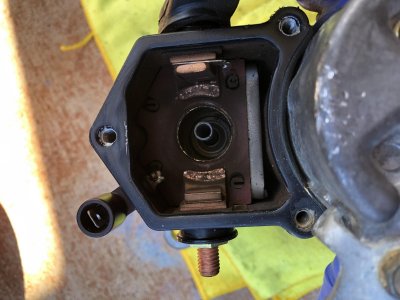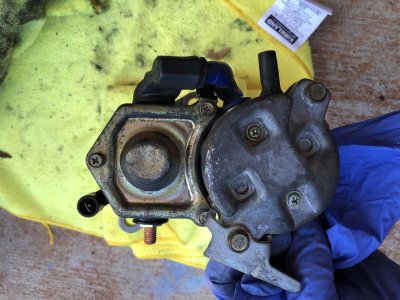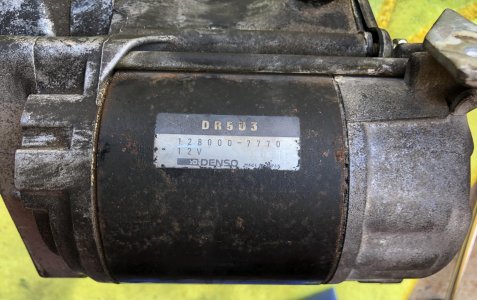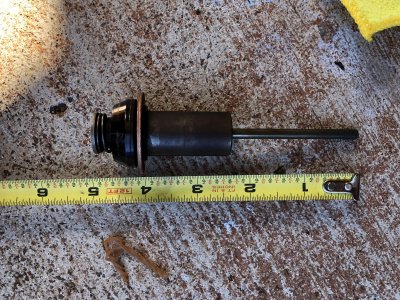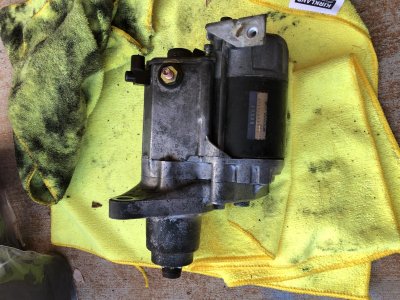If you are feeling a little electrically adventurous, you can do the starter 'acid test'. To do this, you need to put your starter motor back together and install it in the car and connect the main electrical connection (the bolted cable lug). Do not install the starter solenoid control wire - that is the spade connector that fits into the circular fitting on the side of the solenoid. It s visible in your first photo of the starter. Get a length of about 4 feet of "14 - #16 gauge wire and a female spade style crimp connector that will fit the male space connector inside the circular fitting (I think a 1/4" spade connection will do). Crimp the spade connector on to one end of the wire and crimp a male bullet connector on to the other end of the wire. The following is the test procedure:
1) Make sure that the transmission is in neutral, the parking brake is on and that the key is not in the ignition switch
2) Make sure that everything is clear of the engine (alternator belts and stuff) because the engine will spin if the starter works
3) Remove the cover on the engine relay / fuse box to expose the jump start terminal in the fuse box.
4) Plug the female spade connector into the connection on the solenoid.
5) Carefully touch the male bullet connector end of the wire to the jump start terminal in the fuse box. This temporary connection by-passes everything in the car and applies 12 volts directly to the starter solenoid. If the starter is good, the starter will immediately start spinning the engine so just do the test long enough to confirm that the starter is working. This means that your starter is OK and that the problem is someplace else, likely the ignition switch of the starter interlock. If the starter does not spin it means that your starter is faulty which is usually failed contacts in the solenoid; but, could also be other problems.
If you are not feeling electrically adventurous, then do the following:
First, check the condition of the cable clamps that grab the + and - posts on the top of the battery. The clamps can get stretched over time and the metal will actually start to tear with the result that the clamp no longer grips the post resulting in a poor connection (and low voltage). Visually inspect the clamps for damage and try twisting them on the post. If you can twist them on the post chances are that the clamp is shot (unless the retaining bolt has come loose). That usually means that you have to re terminate the battery cables, a job best left to an automotive electrical specialist if you don't have the tools for crimping large cables. Sometimes battery post shims will provide a fix; but, if the cable clamps have started to crack its a temporary fix.
Schumacher BAF-2 Battery Post Shim, Batteries - Amazon Canada
If the battery post connections look good, switch the ignition switch just to the run position. While watching the voltmeter, turn the CCU on and set the fan speed to high and then switch the headlights on. If the voltmeter takes a nose dive when you do this your new battery has a problem or you have a bad electrical connection somewhere. If the voltage stays close to 12 volts then the connections are probably good.
If the battery connections are good do the following test. Watch the voltmeter on the car as you switch from off to the run position. Does the voltmeter go to 12 volts? Do the dash warning lights all go through their power up / self test sequence? The ABS, MIL and SRS lights should light up and then go out after a couple of seconds, the charge and low oil pressure lights should stay on. If the lights don't come on, then chances are you have an ignition switch problem. There are other things that can cause this symptom; but, they are nastier and less common. Get a copy of the 1991 service manual (down load links can be found below)
Service manuals - NSX-Wiki (nsxprime.com)
and in the Electrical section section of the service manual you will find the procedure for removing the ignition switch and testing the ignition switch. It is possible for the ignition switch to just fail on the starter contact; but, the fact that you said that the light around the ignition switch is not lighting up makes me think that the problem might be a little more general.
You said "
When you turn the key it just clunks one time nothing else.", can you confirm that the clunk is coming from the starter / solenoid or is it possible that the noise is coming from the main FI relay (usually more of a click than a clunk)? If the noise is definitely coming from the starter, then the starter interlock circuit and the infamous clutch interlock switch is probably OK. If the noise is not coming from the starter / solenoid then you need to check out the interlock circuit and the clutch stopper button for the interlock switch would be the first candidate. Search on Prime using ' clutch interlock switch' for all the gory details on replacing the interlock stopper button.
As a side note, I keep a length of wire with the bullet connector and spade connector coiled up and in my trunk. Its my back up plan if the clutch switch stopper should ever drop out again. With the key in the run position I can use the jumper wire to spin the starter and start the engine avoiding the need to call a tow truck or organize an ignominious push start - haven't had to do one of those since high school when we to drive around in beat up MGs or Triumph TRs.
